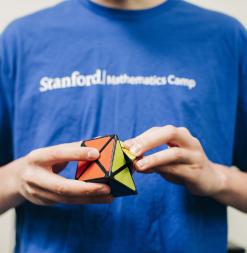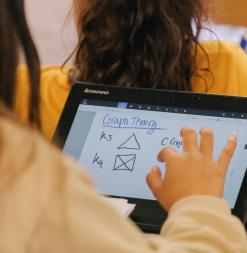Academic Tracks
Program I – Abstract Algebra & Number Theory
Program I topics are introduced through five motivating problems such as limitations of straight-edge and compass constructions, classification of patterns in two dimensions, error-correcting codes, cryptography, and the analysis of symmetry in structures.
The mathematics central to solving these problems comes from the areas of abstract algebra and number theory. Abstract algebra originated in the early part of the 19th century through the study of polynomial equations. This branch of mathematics lies at the core of many areas of modern mathematical research. Number theory concerns the properties of integers and has its origins in ancient mathematics. Number theory remains a very active field of study with interesting open problems and important applications in computer science.
Recommended Prerequisite Mathematics Experience for Program I:
Students applying for Program I should have experience writing and reading mathematical proofs and strong high school geometry and algebra mastery. SUMaC Program I applicants should be comfortable with:
- proofs by induction, contradiction, contrapositive, and more.
- logic used in mathematics such as basic logical symbols and their meanings like if, then, or, and, etc.
- notation for subsets, supersets, and intersections.
Students accepted to Program I have typically studied number theory and are comfortable with modular arithmetic and some basic theoretical results involving modular arithmetic. Prior participation in mathematics competitions or contests is not required.
Program II – Algebraic Topology
Program II centers on algebraic topology, a major area of current mathematics research.
Topology is the study of the properties of shapes that remain unaffected by deformations. For example, a sphere made out of rubber can be deformed into the shape of a cube. While it may appear that a sphere and a cube don't have that much in common, it turns out that they are topologically equivalent in a way that can be made precise mathematically. This course will explore different ways of analyzing topological properties of shapes using algebraic concepts such as the notion of group.
Recommended Prerequisite Mathematics Experience for Program II:
Students applying for Program II should have enough mathematics experience to learn new mathematics quickly. SUMaC Program II applicants should have:
- more proof experience than a Program I student.
- deep, thoughtful interest in higher mathematics (whereas a Program I student might only have experience from mathematics contests or clubs).
- experience with group theory, but it is not required.
Program II students are typically previous participants of Program I or have experience with content from Program I.
Stanford Pre-Collegiate Summer Institutes: Mathematics Courses
If you are not ready for abstract algebra and number theory or algebraic topology, we offer other math courses through Stanford Pre-Collegiate Summer Institutes. Note that Stanford Pre-Collegiate Summer Institutes is another program that requires a different application from Stanford University Mathematics Camp. However, you can use the same application account to begin and submit applications for both programs.
The deadline to apply for Stanford Pre-Collegiate Summer Institutes courses is March 20, 2025.
Number Theory
Discrete Mathematics


